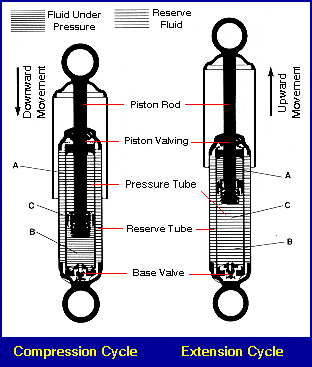WHAT SHOCK ABSORBERS DO
Let’s start our discussion of shock absorbers with one very important point: Despite what many people think, conventional shock absorbers do not support vehicle weight. Instead, the primary purpose of the shock absorber is to control spring and suspension movement.
Shock absorbers are basically oil pumps. As shown in Fig. 1, a piston is attached to the end of a piston rod and works against hydraulic fluid in the pressure tube. As the suspension travels through jounce and rebound, the hydraulic fluid is forced through tiny holes – orifices – inside the piston. However, the orifices let only a small amount of fluid through the piston. This slows down the piston, which in turn slows down spring and suspension movement.

The amount of resistance a shock absorber develops depends on the speed of the suspension and the number and size of the orifices in the piston. Shock absorbers are velocity sensitive hydraulic damping devices, meaning the faster the suspension moves, the more resistance the shock absorbers provide. Because of this feature, shock absorbers adjust to road conditions. As a result, shock absorbers reduce:
- Bounce
- Roll or sway
- Brake dive
- Acceleration squat
Shock absorbers work on the principal of fluid displacement on both the compression and extension cycle. A typical car or light truck will have more resistance during its extension cycle than its compression cycle. This is because the extension cycle controls the motions of the vehicle sprung weight. The compression cycle controls the motions of the lighter unsprung weight.
Compression Cycle
During the compression stroke or downward movement, some fluid flows through the piston from Chamber B to Chamber A, and some through the compression valve into the reservoir, Chamber C. To control the flow, there are three valving stages in the piston and in the compression valves.
At the piston, oil flows through the oil ports, and at slow piston speeds, the first stage opens. This allows fluid to flow from Chamber B to Chamber A.
At faster piston speeds, the increase in fluid pressure below the piston in Chamber B causes the second stage piston valve to open. At high speed, the limits of the second stage phase into the third stage orifice restrictions.
At the bottom of Chamber B, oil that is displaced by the piston rod is passed through the three-stage compression valve into Chamber C.
At slow speeds, the oil flows through an orifice in the compression valve. As the piston speed increases, the fluid pressure increases, causing the disc to open up away from the valve seat. Again, at high speeds the orifice restriction becomes effective.
Compression control, then, is the force that results from the higher pressure present in Chamber B, which acts on the bottom of the piston and the piston rod area.

Extension Cycle
As the piston and rod move upward toward the top of the pressure tube, the volume of Chamber A is reduced, and thus is at a higher pressure than Chamber B.
Because of this higher pressure, fluid flows down through the piston’s three-stage extension valve into Chamber B.
However, the piston rod volume has been withdrawn from Chamber B, greatly increasing its volume. Thus, the volume of fluid from Chamber A is insufficient to fill Chamber B. The pressure in Chamber C is now greater than that in Chamber B, forcing the compression intake valve to unseat. Fluid then flows from Chamber C into Chamber B, keeping the pressure tube full.
Extension control, then, is the force present as a result of the higher pressure in Chamber A, acting on the top side of the piston area.
